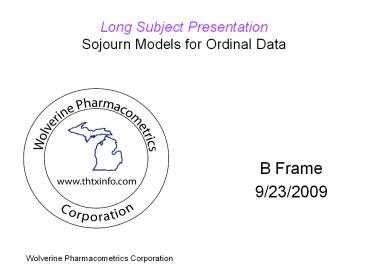Long Subject Presentation Sojourn Models for Ordinal Data - PowerPoint PPT Presentation
Title:
Long Subject Presentation Sojourn Models for Ordinal Data
Description:
This SSP is to cover the details of a model developed for zero heavy ordinal data. ... ETA1. ETA1 4.80E 01. Wolverine Pharmacometrics Corporation ... – PowerPoint PPT presentation
Number of Views:42
Avg rating:3.0/5.0
Title: Long Subject Presentation Sojourn Models for Ordinal Data
1
Long Subject PresentationSojourn Models for
Ordinal Data
- B Frame
- 9/23/2009
2
Background Info
- This SSP is to cover the details of a model
developed for zero heavy ordinal data. - This model is scheduled to be presented at the
October 2009 DIA/FDA/Pharma workshop on Modeling
and Simulation, check their website for a .ppt
download. - This work is also accepted for publication in JPP
with major revision (which I did), but I have no
idea when it might be in print.
3
The Published Model
- Actually was three models, one for each of
dizziness, drowsiness, and dropout. - Here we will focus on a model like the one used
for drowsiness. - Using fake data of course.
4
The Basic Problem
80 of Subjects
0,0,0 0,0,0
0,0,1,1,1,2,2,2,2,2,2,1,1
The Rest
5
Lets Jump Right In!
- Take a look at control stream c400.txt.
- This is a simple Markovian cummulative logit
model for our fake data. - The sojourn aspect and a John Draper random
effect transform are hinted at but not invoked,
yet.
6
Running this control on T1SIM.TXT
ETABAR IS THE ARITHMETIC MEAN OF THE
ETA-ESTIMATES, AND THE P-VALUE IS GIVEN FOR THE
NULL HYPOTHESIS THAT THE TRUE MEAN IS 0.
ETABAR 0.16E01 SE 0.10E00 P VAL.
0.37E-52 OMEGA - COV MATRIX FOR RANDOM EFFECTS
- ETAS ETA1 ETA1
4.80E01
7
(No Transcript)
8
Nomenclature
Data 0 0 0 0 0 0 0 11 1 1 1 .
2 2 2 2 2 3 3 3 1 1 1 1 0 0 0
Day 1 2 3 4 TAE
t
TAE Time of first non-zero AE t last day of
study
9
Likelihood for the data
Before TAE (if it ever occurs) 1- h(j) where j
is the day number and h is the hazard. At TAE
h(jTAE)?Probability of transition from 0 (on day
TAE-1) to 1, 2, or 3 on day TAE After TAE
Probability of transition between previous days
score and the current days score. This is the
standard Markovian ordinal regression probability
as used in c400.txt
10
So what are the pieces / parts?
- Review time to event modeling with attention to
the one change point Weibull hazard for discrete
time. - Review truncated distributions.
- Present coding for NONMEM VI implementation.
11
Time to Event Material
Let X be an observed event time and C be a
censoring time. In our example here the time of
the first occurrence of a non-zero AE, TAE would
be X and C would be the last day of observation
if no non zero AE were observed, here t, the
last day of the study. Additionally, let ? 1 if
X is observed and 0 otherwise. Letting Y min
(X,S), the likelihood for a subjects data
assuming a density f, and survival function S is
12
Functions of Interest for Continuous Time
Processes
Given a density function f(x), we have
The survival function
13
The hazard function h(x)
f(x)/S(x) -d(ln(S(x)))/dx
The cummulative hazard function H(x)
14
And Finally
15
Weibull Example
Density
Survival Function
Hazard function
Cummulative Hazard
16
For Discrete Time
If X is discrete valued, i.e. can only assume
values xj, j 1,2, .
17
One Change Point Weibull
Consider a two part log Weibull cumulative hazard
1 if t? change point
tc Where c 0 of t gt
change point tc And (?1, ?1) and (?2, ?2) are
the Weibull parameters for times ? and gt the
change point, respectively
18
Forcing the two log cumulative hazards to be
equal at the change point..
?
19
Truncation
Our AE scores are 0, 1, 2, or 3 and we will model
these with a cumulative logit model, but at TAE
the only possible transitions are to 1, 2, or 3.
For our model to be a probability model it must
integrate or sum to unity. If we sum up these
probabilities we get the probability that AE?1,
so if we divide each of them by this quantity
and then preform the summation the probabilities
do add up to unity.
20
NONMEM Implementation of Sojourn Part
The data contains a flag (IND1) that is always
zero except at TAE ID DV TIME OLDT IND1 1
0 1 0 0 1 0
2 1 0 1 1 3 2
1 1 1 4 3 0
21
A simple sojourn model c401.txt
/nmdata100indest.csv
TIME TO FIRST AE STRUCTURAL PART WEIBULL
SHAPE PARAMETER ALPH1THETA(1) HILL
COEFFICIENT GAM1THETA(6) MEDIAN TAE USE
SIGMOID EMAX MODEL MED1THETA(3)(1-TDOSGAM1
THETA(4)/(THETA(5)GAM1TDOSGAM1)) IF
(MED1.LE.0) THEN PRINT MED1 EXIT 1
100 ENDIF CHANGE OF VARIABLE (ALPHA,
MEDIAN) -gt (ALPHA, LAMBDA) LAM10.693/MED1ALP
H1 H1ZT1LAM1TIMEALPH1 COMPUTE H(T)
H1ZT0LAM1OLDTALPH1 COMPUTE H(T_)
I1HAZH1ZT1-H1ZT0 COMPUTE INTEGRAL
OF h(t) from T_ to T Q1EXP(-I1HAZ)
1-h(T)
22
The likelihood prior to TAE
IF (NEWIND.NE.2) THEN FLG10 ENDIF IF
(IND1.EQ.1) THEN FLG11 ENDIF LIKELIHOOD
FOR DATA PRIOR TO TRANSITION OUT OF AE0 STATE
IF (FLG1.EQ.0) THEN LQ1 CONTRIBUTION
HERE IS 1-h(T) ENDIF
23
The likelihood at TAE
IF (IND1A.EQ.1) THEN Probabilities for
TRANSITION TO Y1, Y2, Y3 when it is FIRST
transition PA11-P11 CORRECT
LIKELIHOOD SINCE ZERO CANNOT OCCUR HERE
FUDG1P11 PB1(P11-P12)/FUDG1
PC1(P12-P13)/FUDG1 PD1P13/FUDG1 ENDIF LIK
ELIHOOD FOR DATA AT TRANSITION OUT OF AE0 STATE
IF (FLG1.EQ.1.AND.IND1A.EQ.1.AND.DV.EQ.1)
THEN L(1-Q1)PB1 ENDIF IF
(FLG1.EQ.1.AND.IND1A.EQ.1.AND.DV.EQ.2) THEN
L(1-Q1)PC1 ENDIF IF
(FLG1.EQ.1.AND.IND1A.EQ.1.AND.DV.EQ.3) THEN
L(1-Q1)PD1 ENDIF































